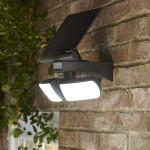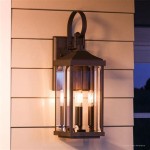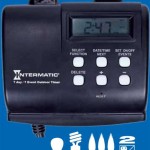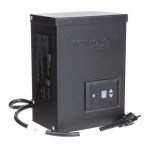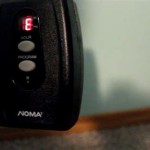```html
Outdoor Wall Lights with PIR LED: Enhancing Security and Efficiency
Outdoor wall lights with Passive Infrared (PIR) sensors and Light Emitting Diode (LED) technology are increasingly popular for residential and commercial properties. These lighting solutions offer a blend of security, convenience, and energy efficiency. Understanding the functionality, benefits, and selection criteria of PIR LED outdoor wall lights is crucial for making informed decisions about property illumination.
A PIR sensor detects movement by sensing changes in infrared radiation emitted by objects, such as humans, animals, or vehicles. When movement is detected within the sensor's range, the connected LED light is activated. This automatic activation provides immediate illumination, deterring potential intruders and enhancing safety for residents or employees navigating the property at night.
LED technology is known for its energy efficiency and longevity. Compared to traditional incandescent or halogen bulbs, LEDs consume significantly less electricity and have a much longer lifespan. This translates to lower energy bills and reduced maintenance requirements, making PIR LED outdoor wall lights a cost-effective lighting solution in the long run.
Key Point 1: Understanding PIR Sensor Technology
The effectiveness of PIR LED outdoor wall lights hinges on the proper functionality of the PIR sensor. These sensors operate by detecting changes in infrared radiation within their field of view. All objects with a temperature above absolute zero emit infrared radiation. The sensor is calibrated to a specific baseline level of infrared radiation. When an object with a different temperature, such as a person moving through the sensor's range, enters the field of view, the change in infrared radiation triggers the light to activate.
Several factors influence the performance of PIR sensors. These include the sensor's sensitivity, range, and mounting height. Higher sensitivity settings can detect smaller movements at greater distances, but may also be more prone to false alarms triggered by factors like small animals or swaying vegetation. The detection range determines the area covered by the sensor, and the mounting height affects both the range and the sensor's ability to differentiate between relevant and irrelevant movements.
PIR sensors often have adjustable settings that allow users to fine-tune their performance based on the specific environment. These settings may include sensitivity adjustments, timer settings that control how long the light stays on after activation, and masking options that allow users to block out certain areas from the sensor's field of view to prevent false alarms. It is essential to calibrate these settings properly to optimize the sensor's performance and minimize nuisance activations.
Environmental conditions can also affect PIR sensor performance. Extreme temperatures, heavy rain, or snow can sometimes interfere with the sensor's ability to accurately detect movement. In such cases, it may be necessary to adjust the sensitivity settings or temporarily disable the sensor to prevent false alarms.
Key Point 2: Benefits of LED Lighting for Outdoor Applications
The advantages of LED lighting for outdoor applications are numerous. LED lights are significantly more energy-efficient than traditional lighting sources, such as incandescent or halogen bulbs. They convert a much higher percentage of electricity into light, with minimal energy wasted as heat. This translates to lower energy consumption and reduced electricity bills.
LEDs also have a significantly longer lifespan than traditional bulbs. A typical LED bulb can last for 25,000 to 50,000 hours or more, compared to 1,000 to 2,000 hours for an incandescent bulb. This extended lifespan reduces the frequency of bulb replacements, saving time and money on maintenance costs. This is particularly beneficial for outdoor wall lights that are often installed in hard-to-reach locations.
LEDs are available in a wide range of color temperatures, allowing users to choose the desired ambiance for their outdoor lighting. Options range from warm white light, which creates a cozy and inviting atmosphere, to cool white light, which provides brighter and more focused illumination. The color rendering index (CRI) of an LED indicates how accurately it renders colors compared to natural sunlight. A higher CRI value indicates more accurate color rendering.
LEDs are also more durable and resistant to shock and vibration than traditional bulbs. They do not contain fragile filaments or glass components that can easily break. This makes them well-suited for outdoor applications where they may be exposed to harsh weather conditions or accidental impacts. Furthermore, LEDs do not contain harmful substances such as mercury, making them a more environmentally friendly lighting option.
Key Point 3: Factors to Consider When Choosing PIR LED Outdoor Wall Lights
Selecting the right PIR LED outdoor wall lights requires careful consideration of several factors. These include the sensor range and sensitivity, the light output and color temperature, the overall design and durability of the fixture, and the ease of installation and maintenance.
The sensor range and sensitivity should be chosen based on the size and layout of the area to be illuminated. A larger area will require a sensor with a longer range. The sensitivity should be adjusted to minimize false alarms while still effectively detecting movement. Consider the mounting height and angle of the sensor to ensure optimal coverage.
The light output, measured in lumens, determines the brightness of the light. The appropriate light output will depend on the size of the area to be illuminated and the desired level of brightness. The color temperature, measured in Kelvin, affects the ambiance of the light. Warmer color temperatures (lower Kelvin values) create a cozy and inviting atmosphere, while cooler color temperatures (higher Kelvin values) provide brighter and more focused illumination.
The design and durability of the fixture are also important considerations. Choose a fixture that complements the architectural style of the property and is made from durable materials that can withstand the elements. Look for fixtures with a high IP rating, which indicates their level of protection against dust and water ingress. A higher IP rating indicates greater protection. Choose a fixture constructed from weather resistant materials such as stainless steel or powder-coated aluminum.
Ease of installation and maintenance are also important factors to consider. Choose a fixture that is easy to install and does not require specialized tools or expertise. Ensure that the bulb is easy to replace when it eventually burns out. Consider the warranty offered by the manufacturer, as this can provide peace of mind and protect against defects in materials or workmanship.
Finally, consider the power source and wiring requirements of the fixture. Some PIR LED outdoor wall lights are powered by mains electricity, while others are solar-powered. Mains-powered fixtures require proper wiring and may need to be installed by a qualified electrician. Solar-powered fixtures are easier to install, but their performance may be affected by weather conditions and the amount of sunlight they receive.
By carefully considering these factors, property owners can select PIR LED outdoor wall lights that provide effective security, enhance convenience, and reduce energy consumption.
The initial investment in PIR LED outdoor wall lights can be offset by the long-term savings in energy costs and reduced maintenance requirements. These lights provide a valuable layer of security and enhance the overall aesthetic appeal of a property.
Proper installation and maintenance are essential for ensuring the long-term performance and reliability of PIR LED outdoor wall lights. Regularly inspect the fixtures for any signs of damage or wear. Clean the sensor lens and the light fixture to remove dirt and debris that can interfere with their functionality. Adjust the sensor settings as needed to optimize performance and minimize false alarms.
```
Nbhanyuan Lighting Led Outside Light With Motion Sensor Outdoor Wall Pir Silver Stainless Steel External Lamp Weatherproof 3000k Warm White For Porch Ip44 1000lm Energy Class E Furniture Home

Auraglow Black Arch Integrated Led Motion Sensor Pir Outdoor Wall Light Adobe Lighting

Cava Outdoor Rectangular Wall Light Pir Sensor Bhs

Auraglow Dusk Till Dawn Daylight Pir Motion Detection Sensor Outdoor Wall Light Wharton Dorton Silver Led Lighting

Integral Led Outdoor Pir Curved Wall Light 7 5w Dark Grey Warm White Express Electrical

Pir Sensor Security Outdoor Wall Lantern Value Lights

Lutec Qubo Led Pir Wall Light Free Delivery

Lutec Curtis Solar Led Wall Light With Pir Free Delivery

Auraglow Pir Outdoor Double Up Amp Down Wall Light Fitting Led Bulbs Included A

Lutec Unite Led Wall Light Black Lighting Direct
Related Posts
